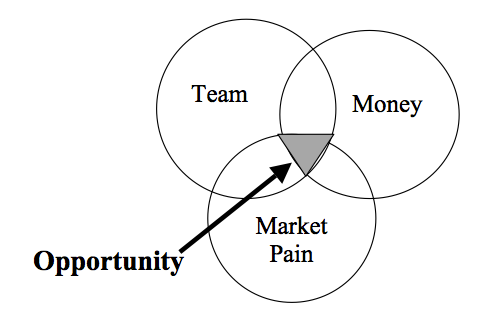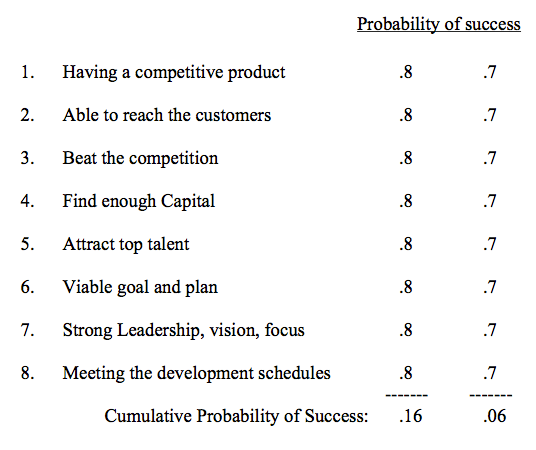1. Recognizing Opportunities![]()
2. Ideas and Opportunities
3. Characteristics of an Opportunity
4. Opportunity in a Technology Based Business
5. Characteristics of a Product Company
6. The 3 R’s of Business
7. What You Need to Enter into a New Business
8. Standard New Business Risks
9. Forces to Counter Standard Risks
10. Assessing a Market
11. How to Get Answers
12. Rules
1.Recognizing Opportunities and their timing is a challenge:
“Man will not fly for 50 years,” Wilbur Wright, 1901
“The nickel-iron battery will put the gasoline buggy…out of existence in no time,” Thomas Edison, 1910
“There is not the slightest indication that nuclear energy will ever be attainable,” Albert Einstein, 1932
“There is no reason for any individual to have a (personal) computer,” Ken Olsen, President and founder of Digital Equipment Corporation, 1977
“There are three steps in the revelation of any truth. In the first, it is ridiculed; in the second it is resisted, and in the third, it is considered self evident.” Arthur Schopenhauer (a long time ago)
2.Ideas and Opportunities
An Idea is:
• An initial concept
• A key step toward solving a problem or creating an opportunity
An Opportunity is:
• A product or service which adds value for its user
• Attractive, durable and timely
Successful ventures:
• Are based on opportunities, not ideas
• Have a thorough understanding of customer needs
• Are shaped by individuals with a drive to “make-it-happen”
3.Characteristics of Opportunities
• Opportunities are developed by intre/entrepreneurs
• Opportunities are situational, born with change, gaps, or inconsistencies in markets
• An opportunity becomes “good” when it is fully consistent with
o the market
o the resources
o the team
What Makes an Opportunity for a Technology-Based Business
1. New Technology. A true invention or a major leap on existing practices in an existing market.
2. New Market for existing technology
3. Change in the environment; i.e. new regulations or laws
4. Others?
Rule: “Never underestimate the tendency for people to resist change”
Absolute key rule:
All opportunities need protection from competition. Your best protection is a large prior investment of money or time. Try to get “R&D” that someone else has paid for (e.g. the government), or has invested significant time.
Established businesses often “purchase” R&D from startups, after the market has shaken out the winners.
(Microsoft’s Philosophy: “Let the market do the R&D”)
It is almost impossible to invent something “on your own”, and have adequate protection.
4.The 3 R’s of Business:
1. Theory of Reality:
a. There is a reality. It is market driven.
b. It is not what you “hope, want or wish” it to be.
c. It is not the way things “appear” to be, it is they way things are
d. Find out what it is, work with it, or it will work against you.
2. Theory of Relativity:
a. Values are relative. These include honesty, success, and hard work.
b. Technology is relative. 500 years ago, a nail was “high tech”.
c. Opportunities are relative. They come and go. Market windows open and shut.
3. Theory of Relevance:
a. Some things are relevant to your goals, some are not.
b. Do not work on the irrelevant things, unless by conscious choice.
5.Characteristics of a Product company:
• Proprietary technology
• Quick response to Market Change
• Constant Innovation
• Large Investment in R&D
• “A” Level People
• Flexible structures
Rule: “As soon as a product makes money, it is obsolete”
The best companies plan their research and product introductions carefully
Rule: “Your product is assumed to work as advertised”
• (It had better work as assumed)
Beware the “one-trick pony”. If you do not have a series of products in your pipeline, you are unlikely to succeed over the long term.
How do you develop new products in “Operationally Excellent” companies, or in “Customer Empathy” companies?
What you need to succeed in a business:
1. Competitive product
2. Market for the product
3. Ability to reach the customers
4. Barriers to competition
5. Access to Capital
6. Strong team, with the drive to win
7. A vision and goal
8. A plan that is doable, and sellable
9. Ability to develop and manufacture the product in cost and time budget
Rule: “There are a lot of ways to make money. Why this one”
6.Standard Risks for a new business venture
Rule: “The odds are against the venture’s success”
Rule: “The single most important ingredient for success is focus”.
9.Forces to Counter Standard Risks: (Quick Check)
Strong Forces:
• Monopoly
• Mandated Usage
• Billion $ Potential
• Proprietary Technology
• Excellent Track Record
Weaker Forces:
• First with High Barriers
• Compelling reasons
• Defined target market
• Superior technology
• Directly Relevant Experience
Rule: “You must have at least two strong forces, or four weaker forces. Otherwise, find a different opportunity”
It is difficult to accurately assess these forces by yourself. You must get feedback from an Honest Mirror, who understands business.
10.Assessing a Market:
1. Who are the customers? Who will buy, and why
2. How do you reach them
3. What does it cost to reach them
4. What do they do today
5. Why would they change
6. Who (at the customer) makes the buying decision
7. Who supplies today’s solution
8. What will they do about us
9. How vulnerable is the market to price
10. What happens to you, if the competition drops their price
11. What are your costs to produce? How do they compare to the competitions’ cost?
12. How much does it cost to support a customer
13. How easy is it to retain a customer
How do you get truthful answers to these questions?
11.How to get the answers:
How many of these questions have to do with the product?
Rule: “The product is assumed. It is your ante into the game. Once you start, stop worrying about the product.”
Rule; “There are a million ways to make money. Why this one?”
Sources of Answers:
1. Survey Customers
2. Test market
3. Focus Groups
4. Call competitors
5. Call customers directly
6. Library, and other published sources
7. Government reports
8. On line: Internet, databases, etc
Your source should be pertinent to the question
If you are entering a new market (e.g. internet) and there are published data, you are probably too late.
Rule: “Never stop this process. The answers are constantly changing”
12.Rules: Market Assessment
• “Never under-estimate the tendency for people to resist change”
• “As soon as a product makes money, it is obsolete”
• “Work with reality, or it will work against you”
• “The product is assumed! It is your ante into the game. Once you start, stop worrying about the product”
• “There are a million ways to make money. Why this one?”
• “Never stop assessing your market.”
• “The odds are against the venture”
• “Have 2 strong, or 4 weak forces; or find a different opportunity”
• “Focus, focus, focus”



